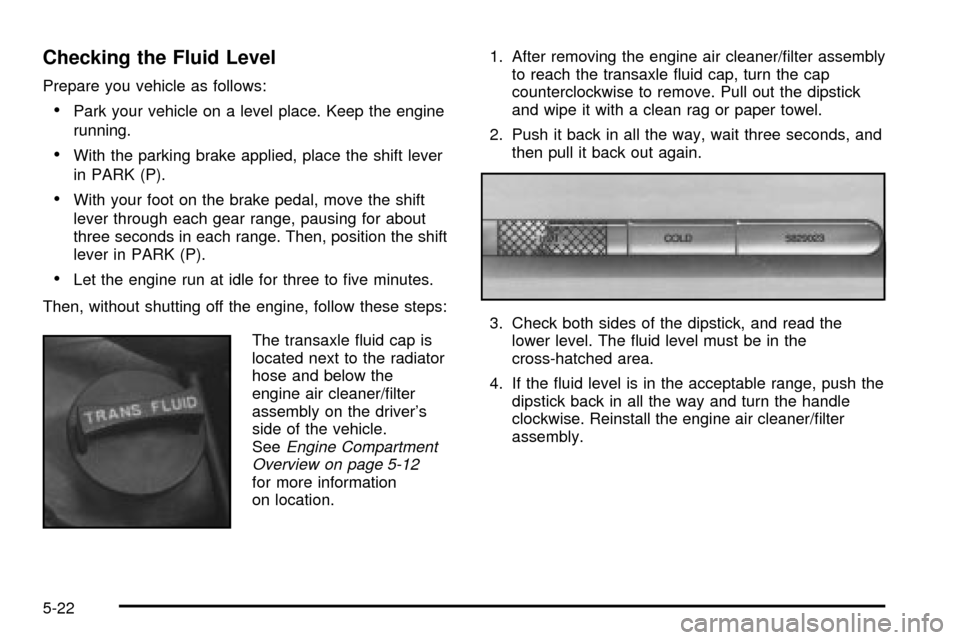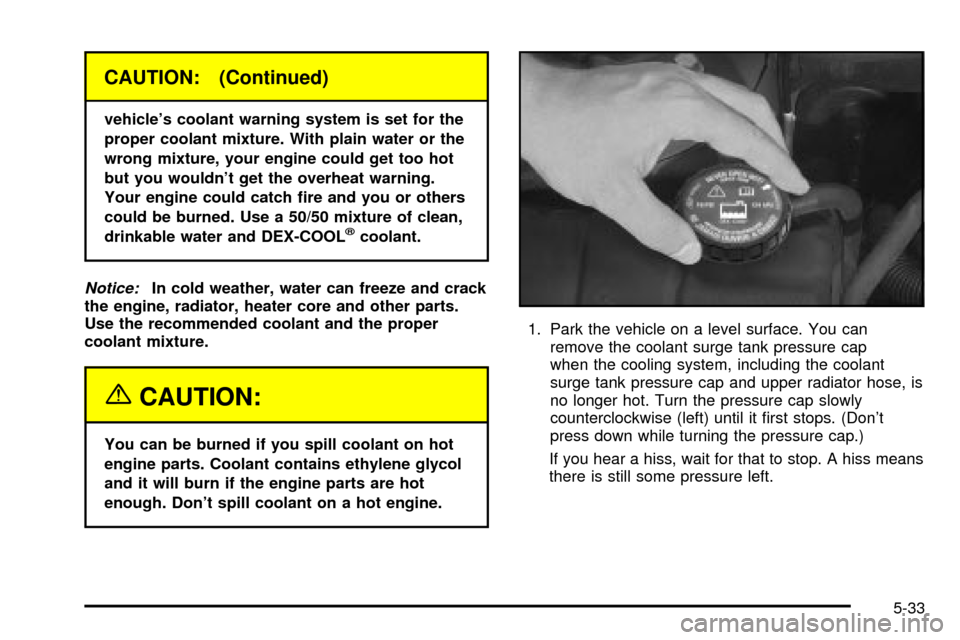clock CADILLAC DEVILLE 2003 8.G User Guide
[x] Cancel search | Manufacturer: CADILLAC, Model Year: 2003, Model line: DEVILLE, Model: CADILLAC DEVILLE 2003 8.GPages: 423, PDF Size: 2.91 MB
Page 279 of 423

An alternate fuel door
release is located inside of
the trunk on the driver's
side. Pull it to release
the fuel door.While refueling, hang the fuel cap by the tether from the
hook on the ®ller door.
To remove the fuel cap, turn it slowly to the left
(counterclockwise). The fuel cap has spring in it; if you let
go of the cap too soon, it will spring back to the right.
{CAUTION:
If you get fuel on yourself and then something
ignites it, you could be badly burned. Fuel can
spray out on you if you open the fuel cap too
quickly. This spray can happen if your tank is
nearly full, and is more likely in hot weather.
Open the fuel cap slowly and wait for any
ªhissº noise to stop. Then unscrew the cap all
the way.
Be careful not to spill fuel. Clean fuel from painted
surfaces as soon as possible. See
Cleaning the Outside
of Your Vehicle on page 5-88.
5-8
Page 280 of 423

When you put the fuel cap back on, turn it to the right
(clockwise) until you hear a clicking sound. Make
sure you fully install the cap. The diagnostic system can
determine if the fuel cap has been left off or improperly
installed. This would allow fuel to evaporate into the
atmosphere. See
Malfunction Indicator Lamp on
page 3-50.
The CHECK GAS CAP message in the Driver
Information Center (DIC) will come on if the fuel cap is
not properly reinstalled.
Notice:If you need a new fuel cap, be sure to get
the right type. Your dealer can get one for you.
If you get the wrong type, it may not ®t properly.
This may cause your malfunction indicator lamp to
light and may damage your fuel tank and emissions
system. See ªMalfunction Indicator Lampº in the
Index.
Filling a Portable Fuel Container
{CAUTION:
Never ®ll a portable fuel container while it is in
your vehicle. Static electricity discharge from
the container can ignite the gasoline vapor.
You can be badly burned and your vehicle
damaged if this occurs. To help avoid injury to
you and others:
·Dispense gasoline only into approved
containers.
·Do not ®ll a container while it is inside a
vehicle, in a vehicle's trunk, pickup bed or
on any surface other than the ground.
·Bring the ®ll nozzle in contact with the
inside of the ®ll opening before operating
the nozzle. Contact should be maintained
until the ®lling is complete.
·Don't smoke while pumping gasoline.
5-9
Page 286 of 423

When to Add Engine Oil
If the oil is at or below the cross-hatched area at the tip
of the dipstick, then you'll need to add at least one
quart of oil. But you must use the right kind. This part
explains what kind of oil to use. For engine oil crankcase
capacity, see
Capacities and Speci®cations on
page 5-101.
Notice:Don't add too much oil. If your engine has
so much oil that the oil level gets above the
cross-hatched area that shows the proper operating
range, your engine could be damaged.The engine oil ®ll cap is
located behind the radiator
on the passenger's side
of the vehicle. For
more information on
location, see
Engine
Compartment Overview on
page 5-12
.
Turn the cap counterclockwise to remove it.
Be sure to ®ll it enough to put the level somewhere in
the proper operating range in the cross-hatched
area. Push the dipstick all the way back in when you're
through.
5-15
Page 293 of 423

Checking the Fluid Level
Prepare you vehicle as follows:
·Park your vehicle on a level place. Keep the engine
running.
·With the parking brake applied, place the shift lever
in PARK (P).
·With your foot on the brake pedal, move the shift
lever through each gear range, pausing for about
three seconds in each range. Then, position the shift
lever in PARK (P).
·Let the engine run at idle for three to ®ve minutes.
Then, without shutting off the engine, follow these steps:
The transaxle ¯uid cap is
located next to the radiator
hose and below the
engine air cleaner/®lter
assembly on the driver's
side of the vehicle.
See
Engine Compartment
Overview on page 5-12
for more information
on location.1. After removing the engine air cleaner/®lter assembly
to reach the transaxle ¯uid cap, turn the cap
counterclockwise to remove. Pull out the dipstick
and wipe it with a clean rag or paper towel.
2. Push it back in all the way, wait three seconds, and
then pull it back out again.
3. Check both sides of the dipstick, and read the
lower level. The ¯uid level must be in the
cross-hatched area.
4. If the ¯uid level is in the acceptable range, push the
dipstick back in all the way and turn the handle
clockwise. Reinstall the engine air cleaner/®lter
assembly.
5-22
Page 294 of 423

How to Add Fluid
Refer to the Maintenance Schedule to determine what
kind of transaxle ¯uid to use. SeePart D:
Recommended Fluids and Lubricants on page 6-15.
If the ¯uid level is low, add only enough of the proper
¯uid to bring the level into the cross-hatched area on the
dipstick.
1. Pull out the dipstick.
2. Using a long-neck funnel, add enough ¯uid at the
dipstick hole to bring it to the proper level.
It doesn't take much ¯uid, generally less than
one pint (0.5 L). Don't over®ll.
Notice:We recommend you use only ¯uid labeled
DEXRONž±III, because ¯uid with that label is
made especially for your automatic transaxle.
Damage caused by ¯uid other than DEXRON
ž±III is
not covered by your new vehicle warranty.
3. After adding ¯uid, recheck the ¯uid level as
described under
How to Check.
4. When the correct ¯uid level is obtained, push the
dipstick back in all the way and turn the handle
clockwise.
How to Reset the Transaxle Fluid
Indicator
After the transaxle ¯uid has been changed, the transaxle
¯uid change indicator must be reset. To reset the
indicator, do the following:
1. Press the INFO button on the Driver Information
Center (DIC) until TRANS FLUID LIFE is displayed.
2. Press and hold the RESET button until 100%
is displayed. This resets the transaxle ¯uid change
indicator.
The percentage of transaxle ¯uid life remaining may be
checked at any time by pressing the INFO on the
DIC until the TRANS FLUID LIFE message appears.
5-23
Page 304 of 423

CAUTION: (Continued)
vehicle's coolant warning system is set for the
proper coolant mixture. With plain water or the
wrong mixture, your engine could get too hot
but you wouldn't get the overheat warning.
Your engine could catch ®re and you or others
could be burned. Use a 50/50 mixture of clean,
drinkable water and DEX-COOL
žcoolant.
Notice:In cold weather, water can freeze and crack
the engine, radiator, heater core and other parts.
Use the recommended coolant and the proper
coolant mixture.
{CAUTION:
You can be burned if you spill coolant on hot
engine parts. Coolant contains ethylene glycol
and it will burn if the engine parts are hot
enough. Don't spill coolant on a hot engine.1. Park the vehicle on a level surface. You can
remove the coolant surge tank pressure cap
when the cooling system, including the coolant
surge tank pressure cap and upper radiator hose, is
no longer hot. Turn the pressure cap slowly
counterclockwise (left) until it ®rst stops. (Don't
press down while turning the pressure cap.)
If you hear a hiss, wait for that to stop. A hiss means
there is still some pressure left.
5-33
Page 326 of 423

5. Firmly grasp the outboard side of the headlamp
assembly with both hands and pull hard enough
so that the whole assembly separates from
the vehicle.6. Remove the bulb
socket dust cover.
7. Turn the headlamp
housing socket
counterclockwise to
unlock the socket from
the lamp housing.
5-55
Page 328 of 423

Front Turn Signal, Sidemarker,
Parking and Cornering Lamps
1. The turn signal lamps are located beside the
headlamp bulbs. To access, lift off the bulb
socket dust cover. See Steps 1 through 6 under
Headlamps on page 5-53.
2. Press the tab down and turn the housing socket
clockwise to unlock the socket from the lamp
housing.3. Remove the turn signal lamp housing socket and
replace the bulb.
4. Reverse Steps 1 and 2 to reinstall.
5-57
Page 348 of 423

{CAUTION:
Getting under a vehicle when it is jacked up is
dangerous. If the vehicle slips off the jack you
could be badly injured or killed. Never get under
a vehicle when it is supported only by a jack.
{CAUTION:
Raising your vehicle with the jack improperly
positioned can damage the vehicle and even
make the vehicle fall. To help avoid personal
injury and vehicle damage, be sure to ®t the
jack lift head into the proper location before
raising the vehicle.
3. Turn the jack handle counterclockwise to lower the
jack lift head until the jack ®ts under the vehicle.
4. Raise the jack until the metal ¯ange ®ts ®rmly into
the channel of the jack head.
5. Put the compact spare tire near you.6. Raise the vehicle by turning the jack handle
clockwise. Raise the vehicle far enough off the
ground for the compact spare tire to ®t under the
vehicle.
7. Remove all wheel nuts and take off the ¯at tire.
5-77
Page 350 of 423

10. Put the wheel nuts back
on with the rounded
end of the nuts toward
the wheel. Tighten each
nut by hand until the
wheel is held against
the hub.
11. Lower the vehicle by turning the jack handle
counterclockwise. Lower the jack completely.
5-79